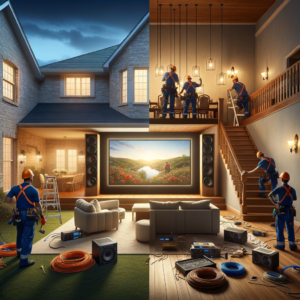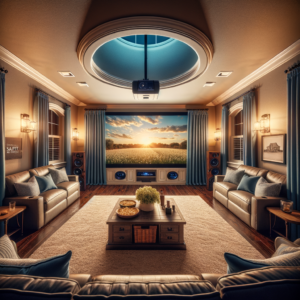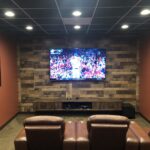For the average person, the little-known science behind surround sound is a foreign language that seems nearly as daunting as learning Mandarin. The truth is, the technology itself is quite simple and can be broken down into parts that anyone can learn. Yes, there are unfortunately a plethora of formats to determine but each can be identified and defined with separate functions that meet different needs. When surround sound first made its debut in the world of audio it was the year 1969 and it was coined “quadraphonic sound”. It started out with audio buffs in a reel-to reel tape. The idea failed in the consumer market because of electronic companies battling over sound formats which resulted in too much confusion. A few years later, surround sound successfully remerged in 1982 after Dolby introduced Dolby Surround, the first functional audio surround similar to what we know today, this format became known as the matrix. Today there are over seven different formats of surround sound, the most commonly known are 5.1, 6.1, 7.1, 9.2, Pro-Logic IIx, Pro Logic IIz and Dolby DSX.
As confusing as it seems, we will help cover the various formats so that next time you enter the electronics store, you know exactly what you’re looking for and will have the knowledge of a seasoned electronics expert.
This early format is specified by the encoding of different sound signals within a stereo source. The matrix rolled out the basis of the original Dolby surround sound and Dolby Pro Logic, it was often used as the format option for VHS tapes. The meat and potatoes of surround sound is simply a strategy of multiple speakers placed to the side as well as a central listening unit. To build further upon the sound, a speaker is placed upon the left and right speakers that specifically renders the dialogue of a movie. This results in a 5 speaker layout which is generally the most basic of a surround sound set-up. As we get into the thick of things, we’ll add more speakers to the party. Pro-logic uses the matrix process of encoding different sound signals through the main left and right channels. Dolby was allowed two extra audio channels this way, usually fed through media such as VHS tapes. The sound was transferred through the center and surrounding speakers but because of the slim space on a VHS, it was limited in producing quality bandwidth. In this method, there was little bass or treble in the sound output.
Dolby reinvented the laser disc as the A-3 (a.k.a. Dolby Digital) which provided users with a lot more storage space, thus resulting in a higher bandwidth. This format also reinforced the addition of low-frequency effects channel was responsible for the “1” in 5.1, which was supported by a sub woofer. Dolby Digital was the first to be utilized in home theatres and became adopted as the default format. The popularity of Dolby Digital reigns today, being used in most surround sound systems as well as Blu-ray discs. Then came the competition, Dolby Digital was the sole leader of surround sound for a time but in 1993, DTS emerged as a worthy opponent. DTS which stands for Digital Theater Systems, was first heard in the theaters with the arrival of the movie Jurassic Park. DTS eventually evolved into LD and DVD, but was originally used on a limited number of discs. DTS uses a higher bizrate which in turn, produces a lot more sound information, the difference in quality is apparent but to some is still considered debatable.
To upgrade to 6.1, a sixth speaker was added to the back center of a room and referred to as a back surround or rear surround. This is what first sparked the confusion, many people already considered surround speakers as rears, which was inaccurate. Adding the sixth speaker in this rear placement, was added to give listeners the impression that something was sneaking up behind them, in effect “tricking” the ear, which had more impact than the side speakers together. The complexity continued when Dolby and DTS released two different 6.1 versions. Eventually, Dolby joined forces with THX and introduced the “EX” or “Surround EX”. This version transferred sound information via Matrix process through the right and left speakers. DTS countered their competition by adding two different versions of 6.1, known as DTS-ES Discrete and DTS-ES Matrix. With ES Discrete, instead of picking sound from other channels, they processed sound information by drawing the data from a programmed DVD or Blue-Ray disc.
The dawn of 7.1 brought the Blu-Ray disc, urging the consumer mark to make the switch to the next biggest thing on the screen. Just as 6.1, there are numerous versions of 7.1 as well but they all add a second rear speaker for enhanced listening. This process is a discrete one, having each speaker process its own information which can be credited to Blu-Ray’s endless storage capacity. Dolby offers two versions of 7.1, the “lossy” version which is Dolby Digital Plus and the “lossless, or Dolby TrueHD, the difference is the lossy uses data compression while the lossy does not. Not to be outdone, DTS also offers their own separate versions of 7.1 that mirror the Dolby versions. The arrival of 9.1 is comes in a form of a comeback for Pro Logic, the Pro Logic processors are a trio that all run off different functions based on need. Pro Logic II is similar to the original processor, using sound transferred from a stereo. Pro Logic llx can be divulged through game, music or movie mode and it can also take a 5.1 and expand it to a 6.1 or 7.1. The Pro Logic llz differs in that it includes the extension of two “front height” speakers that are positioned above and between the main stereo speakers. Using this matrix scenario, the sound has a new perspective because its using different locations in the room.
Audyessy DSX, chiefly known for its AV receivers, expands on the 5.1 and 7.1 formats with an even better approach. The DSX uses even more speakers in its set-up, also utilizing front height and front width speakers for enhancement that can allow up to 11.1 channels of surround sound. Then there’s alternative receiver manufacturers who have released their own improved versions of Dolby and Audyssey’s products that are still in development. The last format to touch on is the 7.2, 9.2 and 11.2, the 2 refers to the two subwoofer outputs on a receiver. Both put out the same amount of information considering there is only one subwoofer track. The “2” was adopted to help the AV marketing of an additional suwoofer output.











